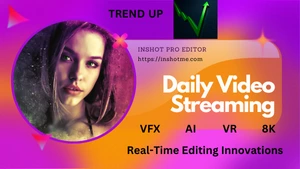DEAR Friends, Video editing has changed a lot over the years. Now, with digital content, social media, and streaming, video editing is easier and more advanced. Technology keeps improving, and new ideas in video editing are coming. These trends will change how creators, filmmakers, and editors work. This article will show some of the most exciting trends in video editing’s future.
Artificial Intelligence (AI) and Machine Learning Integration
One big change in video editing is the use of Artificial Intelligence (AI) and Machine Learning (ML). These smart tools help editors by doing boring tasks like fixing colors, finding scenes, and matching audio automatically. AI tools look at the video and make changes based on patterns, so editors can spend more time on creative work.

For example, AI can go through hours of video and pick out the best scenes. It can also make audio sound better by taking out background noise and fixing sound levels. Soon, AI tools will become even smarter. They may even give editing tips based on the editor’s previous work.
Cloud-Based Editing and Collaboration
Cloud technology is changing video editing, and this change will keep growing. Cloud-based video editing allows editors to work on their projects from any device, anywhere in the world. This is especially helpful for teams working in different places. With the help of cloud tools, team members can work on the same project at the same time and see changes right away.
This helps teams work faster and cuts down on delays. Cloud storage also means editors don’t need to buy expensive equipment, making video editing easier for everyone. As internet speeds get faster with 5G, cloud video editing will become even quicker and smoother.
Automated Video Summarization
With more people watching short videos on TikTok, Instagram Reels, and YouTube Shorts, making short summaries of videos is becoming important. Video summarization uses AI to take long videos and turn them into shorter, interesting clips. This will keep the main idea of the video.
This is helpful for marketers, teachers, and influencers who need short videos fast. AI tools can look through a video and pick out key parts by noticing things like faces, voices, and scene changes. As this technology gets better, it will make even smarter summaries, helping creators make content for different audiences and platforms.
Augmented Reality (AR) and Virtual Reality (VR) Editing
AR (Augmented Reality) and VR (Virtual Reality) are becoming more popular, and video editing is starting to adapt to these new tools. As more people want AR and VR experiences, the need for this kind of content will grow. Editing in 3D needs new tools, which editors will soon use often.
In the future, video editing software may let people edit 360-degree videos, VR, and AR content in real time. This means editors can work right inside virtual spaces to create stories. This lets creators make more exciting, interactive experiences. As AR and VR become part of live events, games, and social media, video editors will need to learn new skills to keep up with these changes.
4K, 8K, and Beyond
As the quality of edited videos improves every day, editing tools are evolving to handle higher resolutions like 4K and 8K. Right now, 4K is common, but 8K is becoming the next big thing. High-resolution videos look sharper and show more details, but they need stronger editing tools and more storage space.
Video editors need to update their computers and software to work with these bigger files. In the future, better ways to save space and store files online will make editing 4K (Try INSHOT Editor for 4K resolution) and 8K videos easier. New improvements like HDR (High Dynamic Range) and color grading will also make videos look even more colorful and realistic.
Real-Time Editing for Live Streaming
Live streaming is now a popular way to create content on platforms like Twitch, YouTube Live, and Facebook Live. As live streaming grows, people will need tools that can edit videos in real time. Content creators want to add effects, transitions, and graphics to their streams without delays.
Real-time editing tools help streamers improve their content while they are streaming, making it more fun for viewers. Features like live overlays, quick scene changes, and instant replays will become common in live streaming software. This will make live streams more interactive and professional.
Motion Graphics and Visual Effects
Motion graphics and visual effects (VFX) are now important parts of many videos, from YouTube clips to big movies. As more people want high-quality VFX, video editing software is adding better tools for making and changing motion graphics.
In the future, video editing programs will probably have easier VFX features. This will help content creators who don’t have special training add professional effects to their videos. This change will allow smaller teams and independent creators to be more creative.
Mobile Video Editing Capabilities
Smartphones are getting stronger, so more people are editing videos on their phones. Apps like InShot, Adobe Premiere Rush, and LumaFusion are already popular with creators who want to edit videos anywhere.
In the future, mobile editing tools will get even better. They will have features that are almost as good as those on computers. Mobile video editing apps will work faster and have more options. Soon, things like multi-track editing, color correction, and visual effects (VFX) will be common on mobile apps. This will make it easy for everyone to edit videos like a pro.
What are the most common video editing mistakes, and how can you avoid them?
Editing Mistakes
- Poor Audio Quality
- Overuse of Transitions and Effects
- Inconsistent Color Grading
- Ignoring Aspect Ratio and Resolution
- Excessive Length
- Poor Timing with Cuts
Solutions
- You should use high-quality microphones and sync audio properly. Always Normalize volume levels and remove background noise with audio editing tools.
- You should use simple transitions like cuts or fades. And Use effects sparingly to enhance the story.
- You should use color correction tools to keep a consistent look and match lighting and colors across scenes.
- You must be familiarized with the platform’s required aspect ratios (e.g., 16:9 for YouTube) and export in the correct resolution for the best quality.
- You should keep videos concise. Cut out unnecessary scenes and focus on the key message.
- Always align cuts with the rhythm of music or dialogue. Please ensure smooth transitions to keep viewers engaged.
What are some video editing skills that are in high demand for freelancers?
Here are some video editing skills that freelancers should have:
It is very important to be good at basic video editing skills. This means knowing how to cut, trim, and arrange clips to make videos smooth and engaging. Many clients need help with simple editing to improve the flow of their videos.
Clients also want their videos to look professional. This is where color correction and grading come in. If you can adjust colors and set the mood with color grading, it can really make a difference.
Good audio is key for great videos. Freelancers who can remove background noise, sync sound with visuals, and mix audio levels are in high demand.
Adding motion graphics and animation can make videos look polished. Skills in programs like After Effects can help your work stand out by adding animated text, logos, or transitions.
Each social media platform, like Instagram, YouTube, and TikTok, has its style and format. Being able to create content that fits these platforms is very valuable.
Visual effects (VFX) can add a wow factor to videos. Clients often look for freelancers with basic VFX skills, like using green screen effects or creating 3D animations.
It’s also important to know how to tell a story through video. Editors who can structure a video to keep viewers engaged are highly valued.
Finally, being skilled in industry-standard software like Adobe Premiere Pro, Final Cut Pro, or DaVinci Resolve is essential for freelance editors.
These skills help freelancers get more clients and stay up to date with trends in video production.
Conclusion
In conclusion, the future of video editing is exciting and full of possibilities. With the advancements in AI, AR/VR, and real-time editing, creators will have powerful tools at their fingertips. These innovations will make video editing easier and more accessible for everyone. As we move forward, embracing these trends will be essential for filmmakers and content creators who want to stay competitive.
By working on essential video editing skills, professionals can create high-quality content that meets the demands of today’s audiences. Keeping up with these changes will help editors produce engaging videos that stand out in a crowded digital space. The future of video editing is bright, and the potential is limitless.
